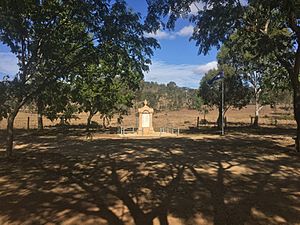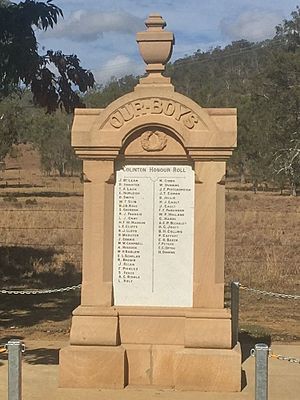Colinton War Memorial facts for kids
Quick facts for kids Colinton War Memorial |
|
|---|---|

Colinton War Memorial, 2016
|
|
| Location | corner of D'Aguilar Highway and Emu Creek Road, Colinton, Somerset Region, Queensland, Australia |
| Design period | 1914-1919 World War I |
| Built | 1917 |
| Architectural style(s) | Classicism |
| Official name: Colinton War Memorial | |
| Type | state heritage |
| Designated | 15 July 2016 |
| Reference no. | 650029 |
| Type | Monuments and Memorials: Memorial/Monument - war |
| Theme | Maintaining order: Defending the country |
| Lua error in Module:Location_map at line 420: attempt to index field 'wikibase' (a nil value). | |
The Colinton War Memorial is a special monument in Colinton, Australia. It's located where the D'Aguilar Highway meets Emu Creek Road. This memorial was built in 1917 to remember the brave men from Colinton who served in World War I. It's a very important part of Queensland's history and is listed on the Queensland Heritage Register.
Contents
History of the Memorial
The Colinton War Memorial was built in 1917. It's made of sandstone and marble. This monument honours the men from Colinton and the surrounding area who fought in World War I (WWI). It is believed to be the earliest WWI memorial monument built in Queensland. This shows how much Queensland cared about this big world event. It also has a special connection to the community in the upper Brisbane Valley.
Early Days of Colinton
The area around Colinton was first settled by farmers in the 1840s. They used the land for sheep and later for cattle. The original Colinton Station was a huge property, covering about 336,000 acres.
More people moved to the Brisbane Valley in the 1870s. This led to a growing timber industry. A sawmill was set up in Colinton in the 1870s. By the 1880s, more land was used for farming. In 1904, the Colinton Estate was divided into 145 farms. These farms were perfect for dairy farming and growing crops.
Dairy farming became very important in the late 1800s. The Brisbane Valley railway line helped transport milk and other farm products. The first dairy factory in the area opened in Lowood in 1890.
Colinton as a Town
The town of Colinton grew to serve the local farming community. In 1907, the Colinton Provisional School opened. A condensed milk factory, the Standard Dairy Company Limited, also opened in Colinton in 1908. This factory was very important for the town's growth. It could process 10,000 gallons of milk every day! It made "Prairie" milk from the local dairy farms.
By 1914, Colinton was a busy town. About 27 people lived there for postal services, and 22 of them were dairy farmers. The factory employed at least 40 local people. The town had houses, stores, and a School of Arts building.
Colinton's Role in World War I
Even though Colinton was a small town with just over 200 people, many men volunteered for WWI. By January 1917, 44 men from Colinton had joined the Australian Imperial Force (AIF).
The idea for the Colinton War Memorial started in May 1916. The community wanted to honour the men who had volunteered. They decided to build a marble slab with the names of these brave soldiers. The local council gave permission to build the memorial at the Colinton School of Arts. This building was the main social spot in town.
On January 18, 1917, the Colinton Honour Board (now the War Memorial) was officially revealed. It was placed right in front of the School of Arts. People believed it was the first monument of its kind in Queensland. It was described as being between 10 and 11 feet tall. The middle part was white marble with names, and the rest was sandstone. The local people of Colinton paid for the memorial themselves.
Many communities in Australia built memorials to remember their soldiers. Some listed only those who died, but Colinton chose to honour all the men who volunteered. They lovingly called them "Our Boys" on the memorial.
The Colinton War Memorial was designed by Frank Williams of F Williams and Co. His company was well-known for making monuments and memorials across Queensland. They built about 15 war memorials in southeast Queensland.
WWI deeply affected all Australian communities. Many young people were lost. Memorials like the one in Colinton were built to honour those who served and died. They were a way for communities to show their grief and remember their soldiers whose bodies were buried overseas.
Out of the 43 men listed on the Colinton memorial, only 13 returned to the area after WWI. By 1922, only five of them were still working in the district.
Changes After the War
After WWI, Colinton changed a lot. The condensed milk factory moved away in 1921. This greatly impacted the town. The population of Colinton district dropped to 181 by 1933.
Dairy farming also declined in the 1950s. Many farmers switched to raising cattle or left the industry. The town of Colinton became much smaller. By 1971, there were no houses left in the main part of the town.
After a big flood in 1974, the local council moved the war memorial. It was moved from its spot near Emu Creek to its current location. This is at the corner of Emu Creek Road and the D'Aguilar Highway.
Today, Colinton is a small area with a service station and the Colinton Memorial Park. The memorial is still a place for people to remember and honour the soldiers.
What the Memorial Looks Like
The Colinton War Memorial is in Colinton Memorial Park. This park is a triangular area at the corner of D'Aguilar Highway and Emu Creek Road. The park has grass and trees.
The memorial is about three metres tall. It has a white marble panel in the middle. This panel is framed by carved sandstone.
The base of the memorial is shaped like an 'I'. Square columns stand on either side of the marble panel. The front of the marble panel says "COLINTON HONOUR ROLL". It lists the names of 43 men from the area who served in WWI. Their names are in two columns.
Above the marble panel is a decorative top part called an aedicule. It has a curved top with the words "OUR BOYS". Below this is a laurel wreath, which is a symbol of honour. The very top of the memorial has an urn, which can be a symbol of death or mourning.
The modern concrete slab, flagpole, metal posts, and chains around the memorial are not part of the original heritage listing.
Why the Memorial is Important
The Colinton War Memorial was listed on the Queensland Heritage Register in 2016. It's important for several reasons:
- It shows Queensland's history: The memorial, built in 1917, shows how Queensland was involved in World War I. War memorials are a way for communities to honour those who served and died. This memorial is the earliest WWI monument known in Queensland.
- It's a great example of its kind: The Colinton War Memorial is a well-designed and beautifully made WWI memorial. It was built by Frank Williams & Co., famous stone masons. It uses classical designs like columns (for honour), urns (for death), and wreaths (for mourning). It's a rare and early example of a stone honour board in Queensland.
- It's beautiful and meaningful: The memorial is important because of its high quality workmanship and design. It stands alone in the countryside, reminding us of the soldiers it honours and the town that once thrived there. This gives it a strong feeling of remembrance and loss.
- It connects with the community: The people of the upper Brisbane Valley paid for the Colinton War Memorial. It has a strong and special connection to them. People still visit it to remember and pay tribute to those who served.


